Glasnost brought a revolution in Soviet art, as the highly intellectual talents created under oppression were threatened by a new generation of commercial artists who looked to the West. In 1988, Andrew Solomon went to Moscow to investigate.

Ilya Kabakov in his studio
“To Brezhnev,” said one of the artists; and since it was nearly sunrise and I was exhausted, I raised my glass of tea without quite registering the name. “To Brezhnev,” we all chorused, and downed our tea; and it was only then that it struck me as odd. Brezhnev? Gorbachev, surely. It must have been four in the morning, or perhaps five, and the conversation had degenerated slightly; we had left Baudrillard and deconstructionism and post-modernism behind, and we were making jokes about Japanese tourists when the toast was proposed. The seven of us were all around a small table in a very small room, all talking at once, and all greedily attacking the food which one of the artists had made, taking turns with the plates because there weren’t enough to go around. Then came this toast, after which someone observed that it had been a good evening of good talk, “just like in the days of Brezhnev.” I was too unfocused even to ask.
By the time we left the studio at half past six, dawn had come to Moscow, and the street seemed incredible. I had been at Fuhrmanny since eleven the previous morning, and it had taken on that quality of being the sole reality, which inevitably comes of protracted debate and ineffable exoticism and total exhaustion. We parted with those words once more: “To Brezhnev!” and then one of the artists reminded me: “Be at the station at noon today. We’ll see you then.”
I went back to the dubious opulence of the Western hotel at which I was staying, and they went to their various homes. At eleven my alarm sounded like a bad joke, and with rather peevish resentment I dragged myself out of bed and set off for the train station, wondering all the while what could have possessed me to make this appointment. When I got there, I saw some familiar avant-gardists, and, discovering that I was glad to see them, ceased to curse the missed night’s sleep and remembered why I’d sat up so late in the first place.
We all went off to a place of great beauty, about two hours outside Moscow. Only one person — there were about 40 of us — knew where we were going, and even he didn’t know what we would find when we got there. We were going to an Action, by the Collective Action Group (C/D), and this mystery was part of it all. When we stopped, we were at the edge of a thin strip of woods, and we walked single file, talking a bit in low voices, sometimes laughing, waiting to see what would happen. After the first bit of wood came great fields of corn, with odd tumbledown houses beyond them; and then came a wood of birches, and then a lake surrounded by reeds newly gone to seed, and then a pine wood with stolid trunks rising from a perfectly smooth floor. Imagine this: all the Moscow vanguard, the many faces of genius and the eager eyes of the hangers-on, all walking through a pine wood as still as the first day of creation.
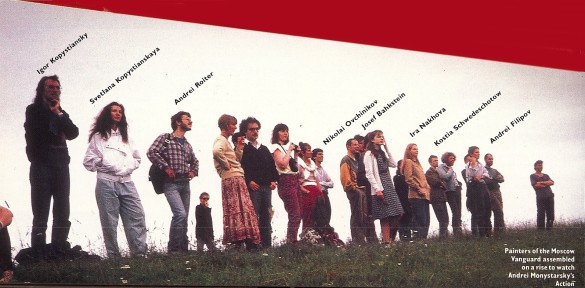
Painters of the Moscow vanguard assemble on a rise to watch Andrei Monastyrsky’s Action.
At the end of the wood we came into a field with a river running through it; and on the river there were Soviet fishermen in rubber boats, casting their lines and watching with some puzzlement, but not much interest, the procession of artists. Then at last we came to a rise, and there we stopped, and stood in a row, and watched the river. And soon we saw an artist, Georgi Kisevalter, standing by the water. He jumped in and swam across and disappeared on the other side. And we watched the spot where he had disappeared. Then he returned to the water’s edge, carrying a huge flat package, with which he leapt back in, and swam back. He went to a hill opposite our rise, where he was joined by Andrei Monastyrsky, leader of C/D, and another artist. They took the brightly-coloured outer wrapping off the package to reveal a large black-and-white painting. Then, carefully, they took out the nails that held the canvas to the stretcher, and laid the canvas on the ground. Then they took apart the stretcher, which was of complicated design, until they had only strips of wood. Then they wrapped the wood in the black-and-white canvas, and wrapped that in the outer covering. Then Monastyrsky distributed Xerox copies of the painting to the onlookers.
All the while, on a hill behind us, a bell was ringing in a blue box and no one heard it.
That was the Action. Two hours there, two hours to go back (not to mention the time to get to the station) and ten minutes of what seemed to be ponderously self-important performance art. We had a picnic which should have been jolly, but I was feeling rather annoyed; these people had just shown themselves not to be friends after all. I was glad to have seen the woods, of course, and the bread and cheese were just dandy, but the rest seemed like idiocy to me, like a betrayal. Sergei Anufriev, one of the leaders of the Medical Hermeneutics movement, took me aside and explained it to me in great detail, articulating elaborate references to previous performance pieces and to art’s connections to nature and to old and now outmoded Soviet artistic concerns and to episodes in people’s lives, and when he finished, I had a moment of thinking. I understood. By that time, I was too tired to worry about it much more.

Erik Bulatov with his painting of Brezhnev as a cosmonaut
It was only later that I understood that I had understood nothing, and that that was the point. By then, I had begun to understand why we were busy toasting Brezhnev, the oppressor, and not Gorbachev, the liberator, whose praises I had expected to hear sung with incredible monotony. Under Brezhnev, as under Khrushchev, the circle of Soviet avant-gardists were unable to exhibit their work in public, and so they would hang it on their walls, and invite people to come and look at it. The only people who ever saw their work were the other members of their circle — the other avant-gardists. They were, in their own phrase, “like the early Christians, or like Freemasons.” They could recognise one another almost at a glance, and they stuck by one another through thick and thin, never betraying the members of the circle. They believe that they knew a higher truth than was vouchsafed to the rest of the Soviet people, but they knew also that its time had not yet come. And from their circumstances of difficulty, they learned integrity, and built a world of mutuality. It was shot through with intense ironies and with petty conflicts, of course, but it was still a life-force, for them giving urgency to existence in a country where for so many people all gesture had come to seem futile. It was in the face of misery that they learned their own secret joy, and the constant surprise of such delight taught them the value of their talent.
And that talent was formidable. The joy may have been great, but the passage to it was too fraught to tempt anyone who was not able to achieve some transcendence, and the frustration of battling a system as all-encompassing as the Soviet one with an inadequate intellect quickly defeated the fools who came to this ship. The Moscow artistic community had no room for the passive observer; it was made up of people whose commitment was enormous. And since the experience of their work always coincided with the experience of them as people, since the 40 or 50 or maybe 60 people who made up the circle of the avant-garde were both the creators of Soviet art and its audience, the personalities of the artists came to be key to what they painted. They have strong personalities, those artists, defined in part by the place they fill within the art world and in part by the proclivities with which they came to the avant-garde; but their genius is, of necessity, the genius of the painter and the genius of the poet and the genius of the actor, and it is this curious concatenation that makes them compelling, irresistible, implacable, and, ultimately, impenetrable. It is why anyone who can get into their world must fall in love with them and must, at the same time, yearn to shake them into coherence and out of their arrogance. It is why they combine that rigorous trait of integrity with a sly elusiveness that all too often can masquerade as dishonesty.
It is why Sergei Anufriev’s description of the Action was a lie. I was being lulled into the belief that what had gone on was comprehensible, coherent, and perfectly straightforward. What had gone on was in fact a fascinating comment on the problems of contemporary Soviet art, and at a fairly literal level it was subject to explication; but it was also an affirmation of the community which oppression had created and which felt itself being shaken by freedom. The whole point was that it contained so many references that no one could begin to get them all; the artists could all affirm their place in the world of the avant-garde by getting many of them, and could confirm the infinite nature of their own secrecy by failing to get the rest. The community of the avant-garde, suddenly over-populated by those who think that being an artist is an easy path to fame and fortune, holds such events to protect its terrible new fragility.
This is the great turning point in Soviet art. Paintings by any given artist are no longer seen only by those who know them as people; they are seen by people who have never been to the USSR and who have no notion of infrastructure and community and the artists’ personalities. I went to the Soviet Union with Sotheby’s, who were conducting the first sale of the work of contemporary Soviet artists, at which works by painters who had never before been seen in the West sold for utterly stupefying sums of money. Sotheby’s deserves some blame and much praise for the way they handled the sale, as a sort of glamorous jet-set historical event, a wildly capitalist celebration of Soviet high seriousness, which changed for ever the world it touched.
Only after the sale had taken place did one of its organisers describe to me, rather revealingly, the first meeting at which Sotheby’s discussed individual artists with the Ministry of Culture. At that time, it was very difficult to get the names of artists or any information about them, and Sotheby’s had put together a list of all the good underground artists whose names they had been able to get from Westerners who had penetrated the USSR. At their first meeting with the Ministry of Culture, they were told, rather peevishly, that every Westerner who came in for a meeting brought exactly the same list, and that it would be identified as really exactly the same list because one of the names on it was the name not of a painter but of a pianist. “Please,” they were begged, “tell people to erase his name from their list. We’re tired of seeing it.”
So Sotheby’s was beginning from the standpoint of as much information as was available at that point, which was not much. That they managed to put together a list which included work by some of the Soviet Union’s best artists — Kabakov, Chuikov, Zakharov — and by some who are very fine indeed — Bruskin, Kopystiansky, Volkov, Dyshlenko, Steinberg, Nemukhin, and several others — is enormously impressive, and the fact that the sale also included work by artists who are really stunningly mediocre is insignificant. What is unfortunate is that the sale and the ultra-deluxe and super-expensive tour for the bidders were billed as hyper-glamorous. At one studio, a woman who in the end placed one of the highest bids of the sale listened to a 30-minutes explanation of the work of a highly theoretical painter. When he finished, she asked two questions: “How many paintings do you do per year?” and then “Do you paint in black and white and grey because it’s hard to get coloured paint in this country?”

Official Portrait by Kostia Zvezdochetov. One of the Perdot paintings, the "official portrait" is of a vampire who bears an uncanny resemblance to a Soviet bureaucrat.
The prettiest paintings sold for the most money in the Sotheby’s sale, and this has thrown the Moscow avant-garde for a terrible loop, because they rather assume that the West is creating a canon based on standards totally unrelated to their own. They dread misinterpretation. They were deeply upset by many of the bidders they met, whose refusal to engage with a Soviet context seemed to imply a total inability to perceive that there was a context with which to engage. While Sotheby’s cannot be held responsible for the bidders’ ignorance, there is no question that had the sale been staged somewhat less theatrically, some of those people would have stayed home. But there is also no question that the paintings would not have brought in such an enormous amount of money. The people who stood around in the lobby after the sale saying, “I’m so glad I bought a painting, whichever one, just to have something to remember this trip by” underwrote the success of even the really second-rate work — and if the sale had not been such a large success, the Ministry of Culture would be far less likely to stage such an event again, or to look with increasing kindness on the artistic community which, once detested, is now finding easy love as a prime source of hard currency for the USSR.
What is really to be applauded, however, is that Sotheby’s contrived to transcend the pedestrian commercialism one has come to associate increasingly with the auction houses. At this sale, even the profit-seeking seemed to spring from a commitment to the general good. Simon de Pury, who conceived, organised, and conducted the sale, went to Moscow four years ago with a vision of communication across worlds that had been strangers to one another for too long. He believed, not inaccurately, that his ability to make vanguard art a recognised source of hard currency for the Soviets would ease the plight of the artists struggling there at the same time that it broke the dreary patterns of belatedness that afflict contemporary Western art. At a farewell dinner in Moscow, the day after the sale, even the most cynical of the Sotheby’s staff — and the most trepidatious members of the Ministry of Culture — were on the brink of tears with the thrill of having created history. It was a miracle of mutuality for both sides, and if one accepts that the function of art is ultimately communication, then this sale was itself a work of art. Whatever the misapprehensions and blunders surrounding it, Sotheby’s acted throughout with that elusive and ultimately very Russian quality of integrity, and for that they deserve the praise of the world.

Zhora Litichevsky, a formidable oarsman as well as a painter, rowing against Western commercialism
Meanwhile, however, the artists had mixed feelings about the sale, and were perhaps unable to see the motivations and reasons behind it. The day after it took place, there was a boat trip to protest against Western commercialism. The avant-gardists were all there. Everyone present argued fiercely about what the effect of the West and its commercialism was likely to be while we sailed the same route to a resort area. Then everyone got off the boat and walked in a wood or sat on the sand or went off and rented little rowing-boats and paddle-boats. I ended up in a rowing-boat with Viktor Misiano, the curator of contemporary art at the Pushkin, and Zhora Litichevsky, a painter with incredible staying-power as an oarsman. Everyone was at play, affirming the strength of the avant-garde community once again; and as paddle-boats tried to bang into us and laughing people tried to splash us, Viktor would say to me, “There is an important Leningrad conceptualist. There is a true Communist painter. There is a Soviet formalist.” It seemed at the time to be an absurd way of meeting people, but later, when I had been to the Action in the woods, I understood that to meet them as a madcap community at play was the best thing that could happen to me.
Sorting them all out is a difficult task, and of course part of what I learned in my time with them is that it is almost impossible for us to judge Soviet art accurately; we inevitably know too little. Furthermore, though, I saw the work of about 60 painters while I was in the USSR, including the work of about 35 painters whom I would definitely classify as falling within the vanguard, one would have to see the work of at least 40 or 50 more people to deem oneself well-informed. Still, one can offer some coherence. There are the official painters who enjoyed recognition before Gorbachev and glasnost and Sotheby’s, and who still have the upper hand in the Union of Artists, and there are some painters who have no official status but work in a vacuum, and these are by and large, but not always, very dull. In the vanguard, there are essentially three generations of painters: the great patriarchs, the brilliant disciples in rebellion, and the somewhat less brilliant young group that looks to the West. The third generation is concentrated in Leningrad, though it has many adherents in Moscow; the others are essentially based in Moscow, where intellect is the most serious game of all.
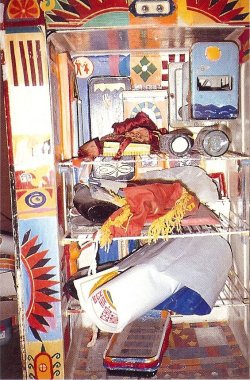
The refrigerator was a project done by the Mukhomor group; the idea was that anyone who came to see it could take or add an object. When the KGB came, they confiscated five of the meaningless objects but left the refrigerator itself.
The history of this art is a tangled one, full of stormy events and strange movements, with affiliations in a constant state of flux. Vladimir Nemukhin, now 63, recalls how in 1944 a teacher took him into a locked room to show him, in secret, reproductions of Van Goghs and Renoirs. This was at the height of the dead period that began with the end of suprematism and continued through the worst days of Stalinism. Artists in the late Sixties, beginning to emerge, developed a style called SOTS art, in which the realities of Soviet life were explored through the realities of painting. There were usually strong narrative elements in paintings, with texts often superimposed on or accompanying images; and whereas “official” painting of this period had an absolutely rigid ideological iconography, these paintings distorted or undermined the most familiar symbols and played clever games with the question of habits of meaning. “Official” art began to tolerate abstraction; vanguard art wanted none of it. Instead of using new vocabulary to express old ideas, it took the old vocabulary of socialist realism and narrative and used it to express dramatic and revolutionary ideas.
In September 1974, the avant-gardists, who had been accustomed to show their art only in one another’s apartments, decided to make their work public, and displayed it in a field outside Moscow. The government’s response was swift and brutal; within the day, the military arrived with bulldozers and ploughed down the work, destroying everything in their reach. International protest followed, and two weeks later, the government, under great pressure, permitted a show at which all artists were invited to participate, the Izmailova Show, which Margarita Tupitsyn has translated as “Soviet Woodstock.” After this, the development towards greater freedom was set in motion. In the early Eighties, when discontent grew, the Mukhomor and related groups were founded, and in October 1982, Nikita Alekseev converted his apartment into a gallery, starting the Aptart movement. Whereas a few years earlier the artists would have been obliged to show their work in apartments, now they showed at Alekseev’s apartment as a self-conscious gesture, a reference to their tradition. The young artists explored their relationship to the older artists, and to the circumstances in which the older artists had worked. Paintings were usually small, in contrast to the monumental scale of “official” art. Unsurprisingly, the Soviet government closed down Alekseev’s apartment/gallery in early 1983, and the Aptartists were obliged to show, in the end, in a field; the “Aptart in Plein Air” exhibition recalled another tradition, but no bulldozers came this time.
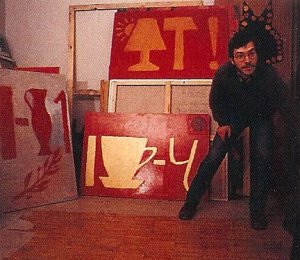
Andrei Roiter with some of the rebus-like paintings that recall the alphabet charts of the Kindergarten
After Aptart, the focus of energy shifted once more, to the Kindergarten, and then later to the Fuhrmanny artists and the other movements of today in Moscow and, with the New Painters, to Leningrad. But in the Soviet Union, history coexists with the present, and many of these movements are still producing extraordinary works of art. The SOTS artists are certainly very much alive, though Komar and Melamid, once the leaders of SOTS art, emigrated to New York in 1977. Ilya Kabakov, who is vastly esteemed by the younger generation of painters, is, with Prigov and Pivovarov, one of the originators of the characteristic SOTS art medium of albums of words and images; he used to read these aloud to the other members of the circle who came to his apartment to see his work. He usually attributes his paintings to a fictive pedestrian painter; they are often fairly realistic scenes on which he imposes long texts, Kabakov’s most recent major work was an installation called Ten Characters for the Ronald Feldman gallery in New York, a recreation of a Moscow cold-water shared flat, in which each room belonged to an individual driven to obsessiveness by the closeness of the quarters. In one room lived the man who never threw anything away, and whose living space was filled with cards on which tiny items were pasted to boards and labelled: lint from my pocket, dust from the corner, a paperclip, an insect. In another room, the man who flew into space from his apartment had rigged a seat in mid-air with four huge springs, which ran to the four corners of his ceiling, planning to fling himself one day into the freedom of the stratosphere. In another room was the composer who combined music with things and instruments, in another the man who flew into his picture, in another, perhaps, Kabakov: the man who describes his life through characters. This huge, moving, strange piece was eminently Russian, tuned, with Kabakov’s characteristic wit, just far enough towards the West to be comprehensible.
Erik Bulatov sometimes paints words in space, huge clear letters cutting back into a sky filled with clouds; sometimes, an image of a powerful Soviet official in a classical portrait setting. The sheer technical ability he manifests has made him into a “new official painter” in the eyes of some of the younger generation; his work will be shown this year at the Pompidou in Paris and subsequently at the ICA in London. Bulatov is the eldest of the painters who gives terror to the familiar images of Soviet ideology simply by painting them over and over again; he need not distort them or treat them ironically to expose their horror. Dimitri Prigov, another artist who began in the SOTS art movement, is more highly regarded as a poet than as a visual artist, though his current visual works are astonishing to behold. Prigov’s role in the community of the avant-garde is that of the man who brings together people and ideas that need to be brought together; small, intense, pellucid, suspicious, and tenacious, he has formed much of what has been produced in the Soviet Union with the force of his criticism. Other SOTS artists, like Grisha Bruskin, whose work brought record prices at the Sotheby’s auction, and the sculptor Boris Orlov, are also significant influences in the Moscow vanguard; with Alekseev, Monastyrsky, the photographer Francisco Infante, and the conceptualist Ivan Chuikov, these seem to be the most influential artists of the older generation.
The middle generation divides itself into schools and groups with wonderful names. In Moscow at the moment, the dominant movements are the Champions of the World, Medical Hermeneutics, the Kindergarten (which has been destroyed, but whose adherents live on), and the Fuhrmanny group (which contains members of the now-defunct Mukhomors); there are also quite a lot of painters who are in knots without names, and some who fall between groups. The Champions of the World (Kostia Zvezdochetov, Kostia Latyshev, Boris Matrosov, and Gia Abramishvili) are idealistic, military, and anti-commercialist. Each morning they assemble and conduct a flat-raising, and then their “commanders” give instructions on the day’s work; in the evening, they destroy whatever they have produced, in a gesture of Decommodification reminiscent of New York in the Sixties. The artists in Medical Hermeneutics (Sergey Anufriev, Pavel Pivovarov, who calls himself Pepperstein, and Yuri Leidermann) have qualms about producing any works of art at all; when I admired Pepperstein’s old drawings, he could only tell me sadly that I was bourgeois and decadent indeed to take pleasure in such things. The Medical Hermeneuticians last year distributed a letter to all the Moscow artists suggesting that they give up their work for a month to think about this moment in Soviet art. In the spring, echoing the commercialism they saw setting in, they rated all the artists in Moscow on the five-point scale of Soviet schools. Now they are busy inspecting things: restaurants, schools, buildings, anything they can think of; their ratings, or perhaps the business of formulating them, are their art.

Andrei Roiter in his studio
The Kindergarten was for a while the centre of the Moscow artists’ world. A few years ago, three artists without studios discovered that watchmen were needed for a Kindergarten that had been closed, and so each of them took one of the eight-hour shifts. They transformed the place into a performance and art centre for themselves and their friends. The artists — Andrei Roiter, Nikolai Filatov, and Herman Vinogradov — took the simple symbols from the walls of the classrooms and incorporated them into art whose many layers conveyed an abundance of spirit and energy. Last year, the Kindergarten was torn down by the Soviet authorities, who mistrusted the extravagance of the artists there, and a barren plot is all that remains of it. In Andrei Roiter’s studio today, there are alphabet blocks and cut-outs and wooden animals peeping out from behind canvases. They, and his paintings, are what is left; his work still has much humour about it, and great visual strength, but in its manic variety it feels uprooted, as though it is searching for new definition.
Perhaps the most compelling group working today, in its variety, its whimsy, and its sheer talent, is the Fuhrmanny group, in a building on Fuhrmanny Road, the first floor of which is the Home for the Blind and the second floor of which is a series of interlinked studios. Soviet artists are assigned studios by the Union of Artists; members of the Union (none of whom has been mentioned in this article) are often given ten-year leases on their studios, whereas non-members are given one-year leases. When I was in Moscow, the Fuhrmanny artists were terrified that they would lose their communal studio space, and that, like the Kindergarten, they would be broken down and cast on the waves of chance, exiled to the far corners of Moscow. I am glad to say that this did not happen, and that for at least one more year the Fuhrmanny artists will be together.
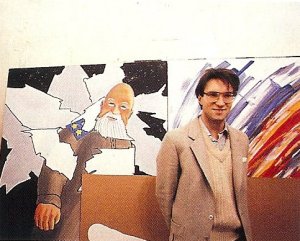
Vladimir Mironenko with one of his paintings at Fuhrmanny
There are seven of them: Kostia Zvezdochetov, Sergei and Vladimir Mironenko (the twins), Vadim Zakharov, Yuri Albert, Andrei Filipov, and Sven Gundlakh. Kostia is the storyteller; Sergei is the sublime egoist; Vladimir is the politician; Vadim is the pessimist; Yuri is the joker; Andrei is the ironist; and Sven is the musician. Kostia, who is also the leader of the Champions of the World, is tiny and wry, with a tiny wry wife who sculpts and is always at the studio. At the moment, he is painting a series of paintings of a mythical country called Perdot, where everyone worships the female and the spirit of repose, which reside jointly in the form of a watermelon. One day, a vampire comes to Perdot and steals all the watermelons, and the people of Perdot are desperate. They cannot reproduce without the melons, their females. Then a hero is born, who finds an underground pipeline and turns off the flow of blood to the vampire’s heart. The vampire shrivels, and the watermelon is saved. Piled around the studio are hundreds of other legends; these paintings have a bizarre coherence of their own, and are sometimes beautiful but always startlingly original. If one could only figure out where Kostia’s ideas come from, one would go there.
The Mironenkos do overtly political paintings, cleverly constructed and technically masterful. Vladimir’s map of the world in five panels (a continent each) with an absent Soviet Union is ornate and mysterious. Sergei’s paintings are funnier, though they can be rich, patterned, beautiful: in one recent one, he mounted photos of himself in a campaign poster, “Sergei for President.” Late one night at Fuhrmanny, Sergei turned to me. “So,” he said. “Now you know me, and you must tell me: am I bourgeois or am I a snob?” Our decision that he was both contained the same degree of irony as most of his paintings.
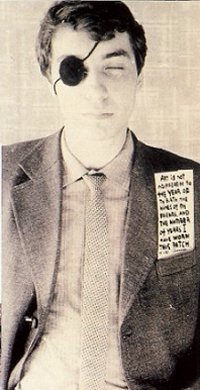
Vadim Zakharov as the one-eyed man who figures in many of his paintings
Zakharov’s painting is much too complicated to explain. Zakharov’s painting is much too complicated for him to explain, but it plays on the idea of a single system that is constantly being complicated and broken down in an unending ritual of form and content. Zakharov’s painting, though usually not conventionally beautiful, is once more utterly original, astonishing to behold, strong and clear and dramatic. He paints mostly in grey, with occasional overlays of yellow tiles, and he often uses the symbols of the elephant (elephant in Russian is an acronym for a kind of prison camp — this is the sort of game in which he revels) and the one-eyed man. For two years. Vadim played the one-eyed man and wore an eye-patch. Such public gesture, when the avant-garde was most a community, lay at its core. One night late at Fuhrmanny, Kostia came downstairs dressed half-jokingly as the priest of the melon from Perdot. These artists dress up to masquerade as their chosen identities.
Yuri Albert does democratic art in little series of paintings: paintings for sailors, paintings for stenographers, paintings for the blind, paintings for the deaf. For sailors, he spells out in semaphore flags: “Hold to a leftward course” — the old cry of the vanguard. For stenographers, he paints political messages in exquisite shorthand. For the blind, raised black domes on the canvas tell their story in braille. For the deaf, human figures gesture in sign-language. On a diptych, Photo-Realism, the first panel is a photograph of a man taking a photograph, the second a painting of a man making the sign for realism.
In one corner of Andrei Filipov’s studio stands a guillotine, with two welcoming crescents cut for two blades to descend at once: it is a guillotine for a double-headed eagle. Filipov’s paintings show scenes of Moscow newly-conceived in decadence. Medieval monks, after the fall of Rome and of Constantinople, used to chant: “Moscow is the third Rome,” and this has become the lyric for one of Sven Gundlakh’s songs and for Andrei Filipov’s paintings. Sven’s paintings are slick and complex, interesting in their oblique angle to his situation in the Soviet Union; he has just written a symphony that must be performed with his paintings as a backdrop, but because he cannot get large enough stretchers to execute those paintings, the symphony remains unperformed.
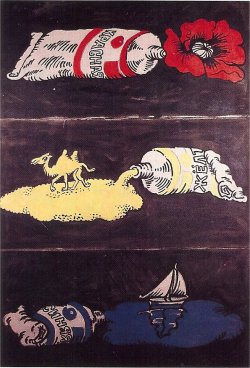
The Yellow, The Red, The Blue, by Yuri Albert
Of course there are others. Nikolai Ovchinikov is one of many talented painters at the fringes of the Fuhrmanny group, and his work is ironical, without, perhaps, the elaborate grace of the Fuhrmanny painters. He repaints familiar paintings with new elements; a famous painting of a peasant woman with a hand pointlessly in the air is given new meaning when an oversized matchstick is put in her hand so that she can scratch her ear. Igor Kopystiansky, from Lvov, appropriates images and uses them like pop-art icons. Gosha Ostretsov, a smart poseur, does paintings and costumes and table-cloths and installations to fight the cause of the Communist party by making its ideals constantly manifest. Zhora Litichevsky, originally a cartoonist, now does decorative mad paintings on sheets of fabric, non-philosophical, darkly humorous, and often very beautiful works of art. There are so many others: Ira Nakhova, whose dreamy paintings rebalance the world; Edward Steinberg, self-appointed heir to constructivism; Vladimir Naumets, painter of darkness; Sergei Volkov, whose emblems deconstruct our most fundamental values; Leonid Purygin, the staunch primitivist; Yuri Dyshlenko, the smooth sad surrealist. Dyshlenko is from Leningrad, but, philosophically, these are all variations on Moscow.
In Leningrad, things are different. In Leningrad, the painters are mind-bogglingly cool, and they hang out with the coolest cats ever. They wear the kind of clothing I have never been able to locate in London or in New York, and they have home videos and they have really spot-on haircuts. In Leningrad, the New Painters are friends with the top rock stars and the top models, and everyone is young and beautiful and everyone eats well and lives well. The Leningrad painters always know how to swing things for you; whereas the Moscow painters have no notion that anyone would want to be a tourist in Moscow — I have yet to see the Kremlin — the Leningrad painters always know someone who will get you past the door or ahead of the queue or around the regulations.
In Leningrad, everyone belongs to the Mayakovsky Club — to which I also now belong — and wears a white button with a red square at its centre. The Mayakovsky club is for people who love Mayakovsky not for his poetry but for his clothes and his hairstyle. In Leningrad, the painters are all big into Andy Warhol and Keith Haring. And Brian Eno. In Leningrad, at four in the morning, I would be in someone’s studio, but we would not be debating art theory. We would be watching crazy David Bowie videos from the late Sixties, laughing at how creepy and sincere David once was, reveling in retro-chic. The members of the Mayakovsky club wrote to Andy Warhol a while ago, and he wrote back, sending them a dozen cans of autographed Campbell’s tomato soup. On the day they learned of his death, they ate some of the soup. They liked it a lot, but had had better.
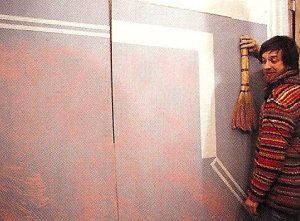
Sven Gundlakh, lead singer in Medieval Russian Eminence and also a Fuhrmanny painter
Sven Gundlakh, in Moscow, is the lead singer in Medieval Russian Eminence, which has a substantial following in Moscow — but it’s an eccentric band, non-professional, a cult group. In Leningrad, the painters hang out with the guys from Kino, which is one of Russia’s top bands, a Soviet equivalent to Madonna that sounds like Kraftwerk with an overlay of Bananarama. The painters themselves all play with Popular Mechanics, which is the brainchild of Sergei Kuryokhin, a musician of extraordinary gifts who is also pretty cool. He improvises: at one of his concerts, he managed to improvise a single theme in and out of two concert orchestras, a rock band, a jazz band, and a Georgian folk music troupe, to indescribable and spectacular musical effect. During this concerts, the painters attack one another with giant inflatable figures of snakes and dinosaurs.
The most visible of the Leningrad New Painters calls himself Afrika, though his name is Sergei Bugaev. He is slender and chiseled and beautiful, only 22 years old, and is fresh from a starring role in a film, Assa, directed by another member of the circle, Sergei Solovyov. Afrika seems to have a lot of money; his apartment, on the Nab. Fontanka, where the video is, has several enormous rooms and a view out over the water. It’s in a building with an elevator. It has a kitchen with a refrigerator many Londoners might covet. Afrika lives with his girlfriend, the stunning Irena Kulksiniteh, who played opposite him in Assa.
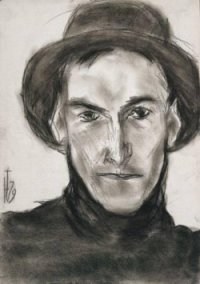
Timur Novikov, Self-Portrait, 1979
Unfortunately, Afrika is not much of a painter; his triumph lies in leading his life as art. The childlike quality of his paintings of the first dogs sent into space or of fantasy ambulances does not quite manage to be naïve. His great friend Timur Novikov, on the other hand, has a keen visual sense and creates works of playful, cheery whimsy. Timur also leads his life as art, and at Mayakovsky’s birthday party this year, which Afrika missed as he was sunning himself at a resort on the Black Sea, Timur made all the speeches, rather well. Timur looks like a high cubist Braque, a face all of strong lines with no apparent bearing on one another. Timur founded the New Painters. Timur is currently working on a novel called Nevsky Prospect II, “which is to Gorky’s Nevsky Prospect as Rocky II was to Rocky.” It’s a Tama Janowitz/Jay MacInerny story of drug dealers and life on the streets and sex and painters in Leningrad. Timur is chock full of anecdotes which he volunteers into the occasional silence: how Léger’s widow pinned the badge of the Mayakovsky club on her baby carriage while smuggling arms during the French underground, or how he grew up without ever going to school, receiving education from crazed and ancient family friends, or how Larionov (second only to Mayakovsky in the iconography) first made it to Paris.
Timur never suffered oppression from the harsh Soviets. When pressed on the issue, he says, in slightly offended tones, that if one really wants to meet people who suffered under the Soviets, he’ll try to find some. In one of Timur’s collages, a few tiny images will float as if suspended at the centre of a large sheet of fabric. Three tiny boats and three tiny clouds, or three tiny houses and three tiny hammers with sickles. One of Timur’s best friends is Gustav, whose real name is Georgi Gurianov, and who is the drummer in Kino. Gustav also writes a lot of Kino’s music. Gustav is very very cool and very good-looking and he cuts not only Timur’s hair, but also his own hair. His visual sense is keen; his work, which is very slick and very commercial-looking, shows the same sense of balance as his haircuts.
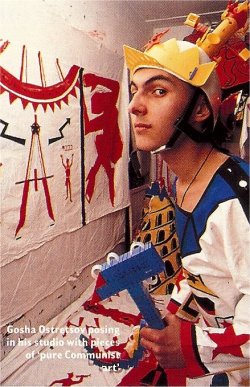
Gosha Ostretsov posing in his studio with pieces of “pure Communist art.”
Whereas the Fuhrmanny artists, say, had strong personalities and created great art, the Leningrad painters have worked out personalities for themselves; they are not of the stuff that makes for undying greatness, but they are of the stuff of the moment, and that they have come into being, in Leningrad, now, makes them fascinating. Andrei Khlobistyn, who works in the library of the Hermitage and is not rich and leisured, is unable for all his intelligence to get the lackadaisical charm of the New Painters into his work. At the fringes of the New Painters there are scads of hangers-on: a naïve and untalented young man called Igor Smirnov, who paints Smirnoff vodka bottles as a trademark, said frankly, “I paint because it’s fashionable. If it stops being fashionable, I’ll stop doing it.”
Unfortunately, it is not likely that painting will cease to be fashionable in Leningrad, but this is one town that Western buying may help in the long run. Though the work of Timur and his talented circle will continue, for a time at least, to be shown with the work of the less gifted painters, it will soon become clear to all that bad painters have as rough a time in a buying economy as inept drug dealers and ugly porn stars. The ones who have a genius for projecting themselves, like Afrika, will survive even this, but the days of the Igor Smirnovs are numbered. When artists are painting work that is only visual, they have to have lots of intrinsic style.
The Leningrad painters see the Moscow painters as less sophisticated and less attuned, and they are right. The Moscow painters see the Leningrad painters as less sophisticated and less analytical, and they are right. The Ministry of Culture sees anything that sells as a godsend for their failing economy, and they are right. The westerners who go there too often see nothing, and that is wrong. The toast to Brezhnev, my first night at Fuhrmanny, for all that it may have been in earnest and with good reason, was also ironical; life is better under Gorbachev, and though there is much progress yet to be made, there is also much progress that has been made. Of course the world of the avant-garde is a fragile world, but it has been bred of strength by people of genius, and inevitably, it will go on, and it will become ever more meaningful, ever richer. In the USSR, communication is still the greatest priority and its difficulties, in their continual flux, are still interesting challenges which can be at least half-met. Moscow is the third Rome, and perhaps the second Paris; but, more to the point, it is the first Moscow. It is a city in which there is a good reason to create art now, in which there are still reasons to paint; as these artists come West, they will change, and so, inevitably, will we.
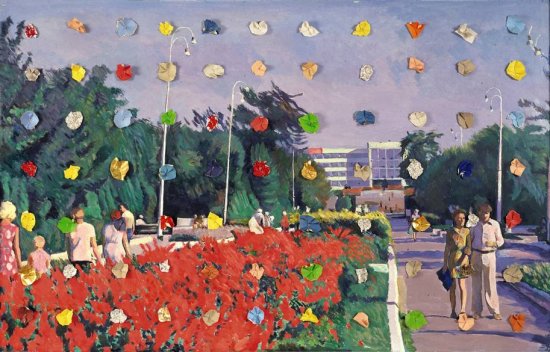
Holidays No. 6, by Ilya Kabakov, 1987











